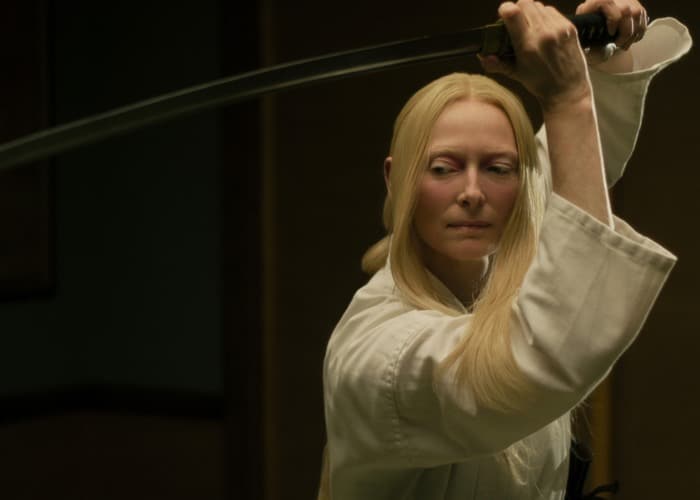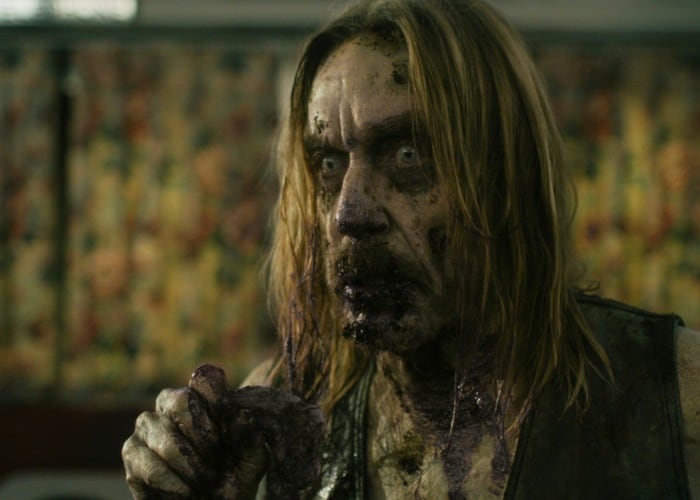
The Dead Don’t Die is the most Jim Jarmusch film you’ve ever seen, making it an apt selection for the opening night slot of the 72nd Cannes Film Festival. Like his 2013 Cannes competition film, Only Lovers Left Alive, this one takes a realist approach to mythical monsters. Alive deals with vampires, Dead deals with zombies. But where Alive is romantic, poetic, dramatic, and dark, Dead is playful, underemphasized, silly, and light.
Alive looks at the lazy lives of several-hundred-year-old immortal vampires merely trying to hide in the modern world. It characterizes these mythical creatures through realistic terms, addressing practical aspects of their survival, connection with nature, emotional state, and more. Dead takes this mythical realism to another level in its metatextual literalism toward the genre. In short, it’s Jarmusch turnt to 11.
The film takes place in the town of Centerville, where an anomalistic doom is settling in as a product of an ecologically devastating resource-mining process called “polar fracking.” Three cops — Cliff (Bill Murray), Ronnie (Adam Driver), and Mindy (Chloë Sevigny) — try to figure out what’s going on as they cruise the town sniffing out the undead that will soon arrive. They speak slowly and simply, never in a rush. Their town is riddled with eclectic country folk, as thematized in Sturgill Simpson’s eponymous country theme song for the film.
The locals include Farmer Miller (Steve Buscemi), the town racist who turns down coffee because it’s “too black” and wears a “Make America White Again” hat despite one of his only neighbors being a kind (yet frustrated) black man named Hank (Danny Glover). There’s Bobby Wiggins (Caleb Landry Jones), a gentle general store clerk chock full of film knowledge, comic book geekery, and pop culture obsessions. There’s Dean (RZA), the wise delivery man for the cleverly named WU-PS (A Wu-Tang reference for anyone unaware of RZA’s source of fame). However, there’s not much to say about these characters’ stories. They’re all embodied references to the arts and to arts culture, breathed to life by Jarmusch’s original vision.
The filmmaker prioritizes tone over plot. But this shouldn’t be confused as substituting substance for style. His moods and tones are brimming with substance. If a plot-heavy film delivers its substance through explicit characterization and drama, a plot-light film is open to deliver it in several ways. Resist the cries to box in films that don’t fit recognizable patterns. Jarmusch fills you through ambiance, unspoken languages, and crafted insular culture. These things comprise the aura he engulfs you in. They shape his uniquely sensible tone. This tone is so dense in The Dead Don’t Die, many will feel like they’re drowning, desperate for a breath of fresh air.

Jarmusch’s bone-dry humor is somehow even drier here, an absolute desert of comedic sensibilities, as he intended it. The most laugh out loud moments come in the form of Ronnie speeding up to the scene of a murder in a red convertible smart car or repetition of an otherwise unfunny line. You can imagine him in the Grand Lumiere Theatre with that thick silver swoosh crowning a tuxedo, sitting next to Tilda Swinton, the two of them giggling to one another the whole time about this bizarre A-list genre vehicle opening the most significant film festival in the world and playing in 600 theatres simultaneously across France (the only film of the festival that will get this widespread viewing treatment). You can imagine them cheekily nudging each other with every passing piece of metatext, a major component of the film.
Swinton, by the way, plays a straight-white-haired Scottish samurai coroner who can code better than Mark Zuckerberg and chop a head off a body cleaner than Beatrix Kiddo. Her name is Zelda Winston — the only two letters not shared with her actual name being the “Ze” of Zelda — a clear meta-reference to the singularity she occupies in her professional career as if she’s an alien blending in as an actor. Driver plays a metatextual version of himself as a young frequent collaborator with Jarmusch calmly clashing with Bill Murray, a much more seasoned Jarmusch collaborator. Jarmusch told press the morning after the premiere that he wrote every character for every recurring actor with that actor in mind, and it shows.
Based on their connection to Jarmusch’s career outside of the film, Murray, Swinton, and Driver had to play the roles written for them, or the roles would have needed to be rewritten. At one point, Zelda spots a Star Wars keychain on Ronnie’s keys. She stops him to note the series as a work of “excellent fiction” to which Ronnie responds with hesitant, almost embarrassed, affirmation. Ronnie/Driver frequently smashes through the fictional sphere to comment on the film they’re in, identifying Simpson’s “The Dead Don’t Die” as the theme song and telling Cliff how much of the script “Jim” shared with him much to Murray’s frustration. Cliff returns the favor in maturely veiled moments, deriding “infernal hipsters [and] their irony,” and talking about his grade school days with Hermit Bob (Tom Waits) in order to assert his veteran status.
There are plenty of small characters who serve a similar meta-textual purpose. RZA is the only Jarmusch collaborator who could have sensibly driven the WU-PS truck. Iggy Pop and Sara Driver are the first zombies to appear, perfectly capturing their roles in Jarmusch’s filmography, Iggy Pop an artistic inspiration and eventual early collaborator and Sara Driver Jarmusch’s earliest filmmaking cohort. Selena Gomez, Luka Sabbat, and Austin Butler play a trio of young city-slickers driving through town that represent the surface-level ideologies and habits popularized on social media by their generation.
Perhaps the strangest and most important metatextual character is Hermit Bob/Waits, Jarmusch collaborator of 33 years. Literally and metaphorically, Bob doesn’t fit in. A long-time resident of Centerville, he has abandoned the civilized part of town to live in the woods where he spies through binoculars and philosophically curses the materialism, destruction, and shallow-minded nature of the people.
Bob is a grand metaphor for Waits, a strange, non-normative, artistically reclusive loner who delivers wild creativity and crucial insight through music and widely celebrated films from greats like the Coen brothers, Francis Ford Coppola, Martin McDonagh, Terry Gilliam, Robert Altman, David Lowery, and Jarmusch. While he doesn’t get the screen time of the stars — true to form — he is the most integral character, piecing together thematic overtones through critical commentary as a conduit for Jarmusch’s voice, which addresses the mythical realm of zombies with such a stark realism, it will be dissatisfying for many. But if you’re into Jarmusch, if you appreciate his tone, if you find him intriguing, you might be into it.
Because he’s an all-timer, you feel lucky to be watching another Jarmusch film for the first 20-30 minutes — truly lucky, like the gods shine down on you once every few years and this is one of those hallowed moments (the best directors inspire this feeling) — but then it begins to feel drowsy, and eventually, it becomes heavy. Perhaps that’s why the vibe after the film was so dismal. It’s a difficult film to lift, despite its simple, sweet nature. It’s heavy in tone, and you must be prepared for that.

You can’t enter with your own expectations. Jarmusch is not thinking the way you’re thinking, and you will be disappointed if you expect him to meet you where you’re at. But that’s also what makes me think this film will age well. Anything this tonally singular is a rarity. Think of movies like Speed Racer and Tron that give themselves so wholly to a design, a mood, and a tone that they are hard not to remember and in some cases, perhaps we’ve realized, were ahead of their time. They may have been derided upon release, but they keep sparking up in retrospectives and film literature. As a rarity a film still must be a certain quality of work, of course, but that doesn’t rule The Dead Don’t Die out.
Like all Jarmusch’s films, it’s stylistically exploratory, beautifully shot, uniquely characterized, full of social commentary, expertly realized. To my point that this is Jarmusch to the max, it should be noted that he scored the film with his band, Sqürl, like he did with Only Lovers Left Alive, the sister film to The Dead Don’t Die. And the score sets the tone of the film perfectly, a moody blend of slow, electric guitars and country instrumentation.
But it’s hard to know how to think and feel about Jarmusch’s new film when he takes it less seriously than he ever has any of his work. He is obviously concerned about the ecological state of our planet. He expresses very clear frustrations and dismissals of pop cultural concepts of politics, consumerism, and scientific study. The film isn’t empty. He’s blatantly making a point with his characterization of the undead who wander around looking for whatever material product they once loved most (chardonnay, Xanax, wi-fi, coffee, etc.). We are the undead, the miserable consumers eating one another alive mindlessly.
However, there’s an underlying sense of resignation that unbalances the commentary, that makes the whole thing feel more like a barren prank than a film teeming with insight. Most notably, he uses Ronnie to virtually deny any possibility of hope from beginning to end, something that consistently frustrates Cliff. Perhaps Dead is Jarmusch wrestling with a wiser, more hopeful version of himself, and a younger, more cynical version. Has existentialism given way to nihilism? Has he given up?
The Dead Don’t Die is difficult to process, but despite the playfully stark tone and theme of quaintly coming to terms with doom, I don’t think Jarmusch has given up yet. At one point, Dean offers Bobby some advice to linger on until his next delivery. “The World is perfect. Appreciate the details.” At his core, this is Jarmusch’s conviction. The world is something worth preserving, worth fighting for. We don’t need to consume all the shit being thrown our way to enjoy and appreciate life. All we need to do is look more closely at the details, a fitting meta-thought for the film itself.
Related Topics: adam driver, Bill Murray, Chloë Sevigny, Jim Jarmusch, The Dead Don't Die, Tilda Swinton, Tom Waits

